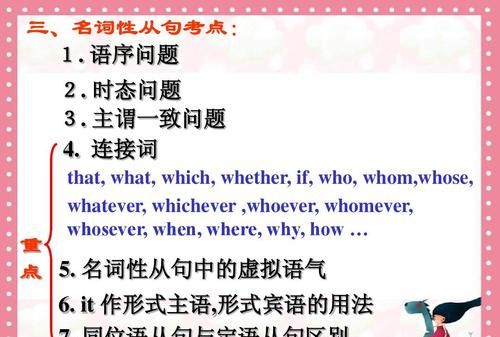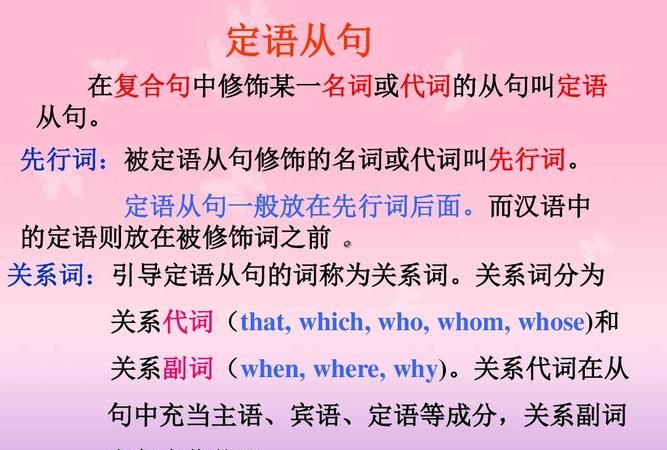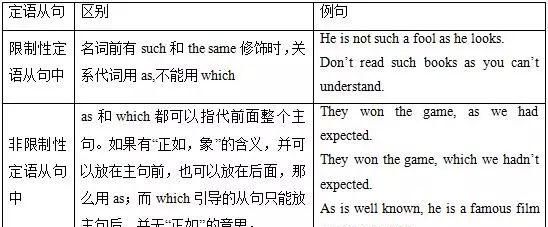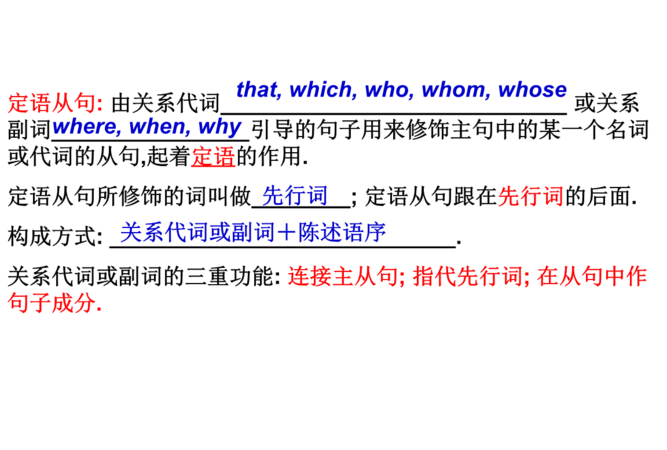本文目录
定语从句修饰主语
关于定语从句修饰主语
定语从句基本概念
在复合句中,修饰名词或代词的从句叫定语从句。
引导定语从句的词叫关系词。
被修饰的名词或代词叫先行词。定语从句一般放在先行词的后面。
2定语从句的关系词
引导定语从句的关系词有关系代词和关系副词。
常见的关系代词包括that, which, who(宾格whom,所有格whose),as 等。
关系副词包括where, when, why等。关系代词和关系副词放在先行词及定语从句之间起连接作用,同时又作定语从句的重要成分。
3 定语从句的分类
根据定语从句与先行词的关系,定语从句可分为限制性定语从句及非限制性定语从句。
1.限制性定语从句紧跟先行词,主句与从句不用逗号分开,从句不可省去。例如:
Any manthat / who has a sense of dutywon’t do such a thing.
任何有责任感的人都不会做这样的事。
2.非限制性定语从句主句与从句之间有逗号分开,起补充说明作用,如省去,意思仍完整。例如:
The house,which we bought last month,is very nice.
这幢房子很漂亮,是我们上个月买的.
注意:非限定性定语从句中不能使用关系代词 that。
4关系代词的用法
1.that
that既可以用于指人,也可以用于指物。在定语从句中作主语、宾语或表语,作宾语可省略。例如:
Mary likes musicthat is quiet and gentle.
玛丽喜欢轻柔的音乐。(that作主语)
The coat(that) I put on the deskis blue.
我放在桌子上的那件外套是蓝色的。(that作宾语)
2.which
which 用于指物,在句中作主语、宾语或表语,作宾语可省略。例如:
The buildingwhich stands near the train stationis a supermarket.位于火车站附近的那座大楼是一家超市。(作主语)
The film(which) we saw last nightwas wonderful.
我们昨天晚上看的那部电影很好看。(作宾语)
3.who, whom
who, whom 用于指人,who 用作主语和表语,whom用作宾语。在口语中,有时可用who代替whom,也可省略。例如:
The girlwho often helps me with my Englishis from England.
经常在英语方面帮助我的那个女孩是英国人。(who 作主语)
Who is the teacher(whom) Li Ming is talking to?
正在与李明谈话的老师是谁?(whom 作宾语)
4.as
①引导限定性定语从句时,指与先行词相似的人或物,必须用于 such/so...as...或 the same...as...结构中,例如:
Such peopleas were mentioned by himwere honest.
被他提到的这样的人是诚实的。
Last term our maths teacher set so difficult an examination problemas none of us worked out.
上学期我们数学老师出了一道我们没有一个人会的数学题。
This is the same bagas I lost yesterday.
这是和我昨天买的包一样的包。
②引导非限定性定语从句时,只能修饰句子,可置于被修饰句子后面、前面或主谓之间,翻译成“正如...那样”例如:
The earth moves around the sun, as we all know.
As we all know,The earth moves around the sun.
The earth, as we all know, moves around the sun
③在非限制性定语从句中,which和as引导定语从句时的区别:
a. which引导的从句不能放在主句前,而as引导的从句则既可以放在主句前,也可以放在主句后,还可以放在主谓之间。
b.as和which都可以指代一个句子,但as有“正如”、“就像”之意,which则没有此含义。
c.as 引导的非限定定语从句只能修饰句子,which 引导的'非限定性定语从句可以修饰句子,也可以修饰名词。
注意:
1.当定语从句中含有介词,介词放在句末时,who,whom, that,which可省略,但介词在关系代词前时,只能用“介词+which/whom”结构。例如:
This is the housein which we lived last year.
这是我们去年居住的房子。
Please tell mefrom whom you borrowed the English novel.
请告诉我你从谁那借的这本英文小说。
2.含有介词的固定动词词组中,介词不可前置,只能放在原来的位置上。例如:
This is the personwhom you are looking for.
这就是你要找的那个人。
3.关系词只能用that的情况:
①先行词被序数词或形容词最高级所修饰,或本身是序数词、形容词最高级时,只能用that,而不用which.例如:
He was the first personthat passed the exam.
他是第一个通过考试的人。
当先行词指人时,偶尔也可以用关系代词who。
②被修饰的先行词为all, any, much, many, everything, anything, none, the one等不定代词时,只能用that,而不用which.例如:
Is there anythingthat you want to buy in the shop?
你在商店里有什么东西要买吗?
当先行词指人时,偶尔也可以用关系代词who。
③先行词被the only, the very, the same, the last, little, few 等词修饰时,只能用that,而不用which.例如:
This is the same bike that I lost.
这就是我丢的那辆自行车。
注意: 当先行词指人时,偶尔也可以用关系代词who。例如:
Wang Hua is the only person in our school who will attend the meeting.
王华是我们学校唯一将会出席这个会议的人。
④先行词里同时含有人或物时,只能用that.例如:
I can remember well the persons and some picturesthat I saw in the room.
我能清楚记得我在那个房间所见到的人和一些照片。
⑤以who或which引导的特殊疑问句,为避免重复,只能用that.例如:
Who is the girlthat is crying?
正在哭泣的那个女孩是谁?
⑥主句是there be 结构,修饰主语的定语从句用that,而不用which.例如:
There is a book on the deskthat belongs to Tom.
桌子上那本书是汤姆的。
4.关系词只能用which,而不用that 的情况:
①先行词为that, those时,用which, 而不用that.例如:
What’s thatwhich is under the desk?
在桌子底下的那些东西是什么?
②关系代词前有介词时,用which,而不用that.例如:
This is the roomin which he lives.
这是他居住的房间。
③引导非限制性定语从句,用which, 而不用that.例如:
Tom came back,which made us happy.
汤姆回来了,这使我们很高兴。
5关系副词的用法
1.when指时间,其先行词表示时间,在句中作时间状语。例如:
This was the timewhen he arrived.
这是他到达的时间。(when=at which)
2.where指地点,其先行词表示地点,在句中作地点状语。例如:
This is the placewhere he works.
这是他工作的地点。(where=at /in which)
3.why 指原因,其先行词是原因,起原因状语作用。例如:
Nobody knows the reasonwhy he is often late for school.
没人知道他为什么上学总迟到。(why=for which)

英语定语从句经典例句
高中定语从句经典例句 篇1
1)I went to visit the American author who wrote a number of books about China.
2)I ate the soup my aunt prepared.
3)I have an arrangement with my bank,by which they let me use their money and repay them next month.
4)He sent her a letter,in which he said that he was sorry for what he had done to her.
5)Mr.Brown,who just came from Britain yesterday,will teach us accounting this term.
6)She is going to spend the winter holidays in Hainan,where she has some relatives.
7)The United States is known for its supermarkets,where huge quantities of all kinds of food and household articles are sold.
8)The story happened in late 19th century,when China is suffering from the invasion of western powers.
高中定语从句经典例句 篇2
as引导的定语从句
在一些习惯用法上,as能兼作关系代词、关系副词,经常引导定语从句。
惯用型1:
such… as…像……一样的
the same…as…与……同样的
I seldom meetsucha beggarasI met today.
我很少碰到今天这样的乞丐。
(as是代词,在定语从句中作宾语)
Please choosesuchapplesascan be put in my bracket.
请选择我能放入篮子里这样的苹果。
(as在定语从句中作主语)
I am notthe samekind of personasyou are.
我可不是和你一类的人。
(as在从句中作表语)
You may takethe samebusaswe take.
你可乘坐我们坐的同一辆大巴。
(as在从句中作宾语)
惯用型2:
such as…
在这种场合,such是代词,表示“这种人、这种物”,as是关系代词。
He is notsuchasyou can imagine.
他不是你能想象得到的那种人。
We have got a lot of drinkssuchasyou can find in supermarkets.
我们习了大量在超市能找到的那种饮料。
惯用型3:
as……,as…
as引导的定语从句,有时像非限制性定语从句一样修饰整个主句或者主句的一部分,但它的位置比较灵活,可以放在被修饰的主句后面,也可以放在主句前面。
例如:
Asyou can see,we are all students.
你能看得出,我们都是学生。
=We are allstudents,asyou can see.
=We are all students,whichyou can see.
(这是详细的解读,大家请熟悉啊)
Asyou know,we need to hurry up.
大家知道,我们需要加快速度。
He is not very honest,asyou have proved.
她不是很诚实,这一点你已证实了。
高中定语从句经典例句 篇3
1)Then I decided to leave,feeling a weight at my heart,such as I have never had before.
然后我决定离开,心里感到一种以前从来没有过的心情。
2)We had hoped to give you a chance,such as nobody else ever had.
我们本来希望给你一次机会,一个别人从来没有过的机会。
3)HedescribeshappeningssuchasIseearoundme.
他所描写的事情就象我看到在我周围所发生的。
4)Ihavenoaspirationssuchasyouimputetome.
我可没有你归罪于我的这些欲望。
such + as引导的定语从句还可用作主语或宾语。 如such指代人,相当于those who; 如such指代物,相当于what或 whateve,all/anything that 等。
1)Such as have knowledge and skillwill not want to work.(相当于those who have knowledge and skill)
有知识和技能的人不愁没有工作。
2)Such as alter in a momentwin no credit in a month.(相当于those who alterin a moment)
那些朝令夕改的人是不会获得人们长久信任的。
3)Associate withsuch as will improve your manner.(相当于those who will improve your manner)
要或那些能提高你礼貌修养的人交往。
4)Such as remains after taxwill be yours when I die.(相当于what remains after tax)
我死以后全部财产除了税以外都给你。
5)You may choosesuch asyou prefer.(相当于what you need)
你可挑选自己想要的东西。
6)I haven’t much many specimens but I will send yousuch asI have.(相当于all that I have)
我有的标本不多,不过我愿把所有的标本送你。
高中定语从句经典例句 篇4
that常用作关系代词,可指代某人,也可指代某物,指物时有的时候可用which替换that,指人时可用who替换。但在下列情况下,一般用that。
一、that指代某物事时
1.先行词为all,few,little,much,the one,something,anything,everything,nothing等时。如:
(1)We'll do all that we can to protect the endangered plants and animals.
我们将尽我们的最大努力来保护那些濒危的动植物。
(2)There is much that I wan to tell you.
我有很多想要告诉你的话。
(3)Is there anything that I can do for you?
有什么我可以帮你的吗?
2.先行词被all,every,no,some,any,(a)few,(a)little,much等限定词修饰时。如:
(4)You can borrow any book that you want to read in our school library.
在我们图书馆,你可以借任何你想读的书。
3.先行词被序数词或形容词最高级修饰时。如:
(5)This is the most beautiful city that I've ever seen.
这是我见过的最漂亮的城市。
4.先行词被the only,the very,the right,the last 等修饰时。如:
(6)This is the very factory that they visited last summer holiday.
这恰好是他们去年参观的那个工厂。
(7)This is the only painting in this style that we have.
这种风格的画我们仅有一幅。
5.先行词是并列结构,既有人又有物时。如:
(8)He talked happily of the writer and his books that interested him.
6.先行词前有the same 修饰,表示和先行词是同一物时。如:
(9)This is the same purse that I lost yesterday.
这就是我昨天丢的那个钱夹。
注:如果表示的是与先行词同一类或相似的某物,则用the same…as….如:
(10)This is the same purse as I lost yesterday.
这个钱夹和我昨天丢的那个一样。
7.先行词为数词时。
(11)Look at the books on the bookshelf.You can see the two that you bought me for my birthday.
瞧书架上那些书。你可以看到我过生日时你买的那两本。
8.如果which引导的定语从句中又含有一个定语从句,为避免重复,第二个定语从句用that。如:
(12)They built a factory which produced things that had never been seen.
他们建了一工厂,生产以前从未见过的东西。
9.以which作主语开头的特殊问句,为了避免重复,定语从句用that。如。
(13)Which is the bus that you will take?
你要乘的是哪一班车?
10.关系代词在定语从句中作表语时,而且通常省略。如:
(14)My hometown is no longer the place that it used to be.
我的家乡再也不是以前那个样子了。
11.关系代词在there be 句型中作主语时,而且常可以省略。如:
(15)This is the fastest train (that)there has ever been.
这是有史以来最快的列车。
二、that 指代某人时。
1.泛指某人时。如:
(16)He is a man that is never at a loss.
他是一个从未一筹莫展的人。
2.主句是以作主语的who开头的特殊问句,为了避免重复时。如:
(17)Who is the person that is talking with our headmaster?
和我们校长说话的那人是谁?
3.先行词前有the same时。如:
(18)This is the same man that gave us a talk last year.
这和去年给我们作报告的是同一人。
4.关系代词在定语从句中作表语时。如:
(19)He has changed.He was not the man (that)he was 10 years ago.
他变了。他再也不是10年前的他了。
另外,that也可用作关系副词,表示时间、地点、原因和方式,在口语中可以用来代替when,where,why 引导的定语从句。在以下名词day,year,time,moment,reason,place等作先行词时,可用that作关系副词引导定语从句。如:
(20)I'll never forget the day (that)I joined the League.
我永远不会忘记我入团的那一天。
(21)Is this the reason (that)they were late for the meeting?
这就是他们开会迟到的原因吗?
(22)We want to find a place (that)we can have a picnic.
我们想找一个我们能野餐的地方。
(23)This is the first time that I have been abroad for traveling.
这是我第一次到国外去旅游。
(注:先行词是time,前面有序数词或last修饰时,常用that引导定语从句或者省略。)
当先行词为表示方式的词the way时,可用that引导定语从句,that常可以省略。
(24)I don't the way you speak to her.
我不喜欢你和她说话那种方式。
高中定语从句经典例句 篇5
定语从句在初中英语中的重要性主要体现在完形、阅读和写作中,因此,能否较好的掌握定语从句直接关系到你英语成绩的拔高。其实,定语从句并不难.
一.定语从句的概念
在复合句中,修饰某一名词或代词的从句叫定语从句。被修饰的名词或代词叫先行词,引导定语从句的词叫关系词,定语从句一般放在先行词的.后面。
二.引导定语从句的关系词
引导定语从句的关系词有关系代词和关系副词,常见的关系代词包括that, which, who(宾格whom,所有格whose)等,关系副词包括where, when, why等。关系代词和关系副词放在先行词及定语从句之间起连接作用,同时又作定语从句的重要成分。
三.定语从句的分类
根据定语从句与先行词的关系,定语从句可分为限制性定语从句及非限制性定语从句。限制性定语从句紧跟先行词,主句与从句不用逗号分开,从句不可省去。非限制性定语从句与主句之间有逗号分开,起补充说明作用,如省去,意思仍完整。
四.关系代词的用法
1.that 既可以用于指人,也可以用于指物。在从句中作主语、宾语或表语。作主语时不可省略,作宾语可省略。例如:
Mary likes music that is quiet and gentle.
玛丽喜欢轻柔的音乐。(that作主语)
The coat (that) I put on the desk is blue.
我放在桌子上的那件外套是蓝色的。(that作宾语)
2.which用于指物,在句中作主语、宾语或表语。作主语不可省略,作宾语可省略。例如:
The building which stands near the train station is a supermarket.
位于火车站附近的那座大楼是一家超市。(作主语)
The film (which) we saw last night was wonderful.
我们昨天晚上看的那部电影很好看。(作宾语)
3.who, whom用于指人,who 用作主语,whom用作宾语。在口语中,有时可用who代替whom。who和whom作宾语时也可省略。例如:
The girl who often helps me with my English is from England.
经常在英语方面帮助我的那个女孩是英国人。(作主语)
Who is the teacher (whom) Li Ming is talking to?
正在与李明谈话的老师是谁?(作宾语)
注意:
(1)当定语从句中含有介词,介词放在句末时,who,whom,that, which可省略,但介词在关系代词前时,只能用介词+which/whom结构。例如:
This is the house in which we lived last year.
这是我们去年居住的房子。
Please tell me from whom you borrowed the English novel.请告诉我你从谁那借的这本英文小说。
(2)含有介词的固定动词词组中,介词不可前置,只能放在原来的位置上。例如:
This is the person whom you are looking for.
这就是你要找的那个人。
(3)that 作介词的宾语时,介词不能放它的前面,只能放在从句中动词的后面。例如:
The city that she lives in is very far away.
她居住的城市非常远。
(4)关系词只能用that的情况:
a.先行词被序数词或形容词最高级所修饰,或本身是序数词、基数词、形容词最高级时,只能用that,而不用which.例如:
He was the first person that passed the exam.
他是第一个通过考试的人。
b.被修饰的先行词为all, any, much, many, everything, anything, none, the one等不定代词指物时,只能用that,而不用which.例如:
Is there anything that you want to buy in the shop?
你在商店里有什么东西要买吗?
c.先行词被the only, the very, the same, the last, little, few 等词修饰时,只能用that,而不用which.例如:
This is the same bike that I lost.
这就是我丢的那辆自行车。
d.先行词里同时含有人或物时,只能用that, 而不用which.例如:
I can remember well the persons and some pictures that I saw in the room.
我能清楚记得我在那个房间所见到的人和一些照片。
e.以who或which引导的特殊疑问句,为避免重复,只能用that.例如:
Who is the girl that is crying?
正在哭泣的那个女孩是谁?
f.主句是there be 结构,修饰主语的定语从句用that,而不用which,例如:
There is a book on the desk that belongs to Tom.
桌子上那本书是汤姆的。
(5)关系词只能用which,而不用that 的情况:
a.先行词为that, those时,用which, 而不用that.例如:
Whats that which is under the desk?
在桌子底下的那些东西是什么?
b.关系代词前有介词时,which,而不用that.例如:
This is the room in which he lives.
这是他居住的房间。
c.引导非限制性定语从句,先行词指事物时,用which, 而不用that,例如:
Tom came back, which made us happy.
汤姆回来了,这使我们很高兴。
五.关系副词的用法
1.when指时间,其先行词表示时间,when在定语从句中作时间状语。例如:
This was the time when he arrived.
这是他到达的时间。
2.where指地点,其先行词表示地点,where在定语从句中作地点状语。例如:
This is place where he works.
这是他工作的地点。
3.why 指原因,其先行词是原因,why在定语从句中做原因状语。例如:
Nobody knows the reason why he is often late for school.
没人知道他为什么上学总迟到。
好啦,关于定语从句,你学会了吗?

の做定语从句的主语
(1)定语从句:就是在复合句里充当定语的从句,它通常紧靠在所修饰的名词或代词后面。
(2)先行词:就是被定语从句修饰的名词或代词。
(3)关系词:引导定语从句的词叫关系词。关系词有关系代词who,
whom,
whose,
which和that等;关系副词有when,
where,
why等。关系词不仅起连接作用,而且还代表先行词并在定语从句中担任某一句子成分,关系代词作主语、宾语、定语、表语等,关系副词作状语。如:
This
is
the
book
that
my
father
bought
me
yesterday.
这就是我父亲昨天帮我买的那本书。
做对外汉语教师是可以提高外语的,但是需要持有一定的教学资质才可以任职。

定语从句修饰主语
在学习定语从句时,我们要学会怎么判断它是修饰主语还是在修饰宾语!以下是定语从句修饰主语的用法,一起来学习吧!
如何判断定语从句是修饰主语还是宾语
定语从句修饰主语时放在主语的后面,修饰宾语时则放在宾语的后面。
一个简单句跟在一名词或代词后(先行词)进行修饰限定,这个句子就叫做定语从句。在主句中充当定语成分。
被修饰的词叫先行词。定语从句不同于单词作定语的情况,它通常只能放在被修饰的词(即先行词)之后。定语 从句由关系词(关系代词、关系副词)引导,关系代词、关系副词位于定语从句句首。
一、关系代词引导的定语从句
关系代词所代替的先行词是人或物的名词或代词,并在句中充当主语、宾语、定语等成分。关系代词在定语 从句中作主语时,从句谓语动词的人称和数要和先行词保持一致。
1)who, whom, that
这些词代替的先行词是人的名词或代词,在从句中所起作用如下:
Is he the man who/that wants to see you?
他就是想见你的人吗?(who/that在从句中作主语)
He is the man whom/ that I saw yesterday.
他就是我昨天见的那个人。(whom/that在从句中作宾语)
2) Whose 用来指人或物,(只用作定语, 若指物,它还可以同of which互换), 例如:
They rushed over to help the man whose car had broken down. 那人车坏了,大家都跑过去帮忙。
Please pass me the book whose (of which the) cover is green. 请递给我那本绿皮的书。
3)which, that
它们所代替的先行词是事物的名词或代词,在从句中可作主语、宾语等,例如:
A prosperity which / that had never been seen before appears in the countryside. 农村出现了前所未有的繁荣。(which / that在句中作主语)
The package which / that you are carrying is about to come unwrapped. 你拿的包快散了。(which / that 在句中作宾语)
二、关系副词引导的.定语从句
关系副词可代替的先行词是时间、地点或理由的名词,在从句中作状语。
1)when, where, why
关系副词when, where, why的含义相当于"介词+ which"结构,因此常常和"介词+ which"结构交替使用,例 如:
There are occasions when (on which) one must yield. 任何人都有不得不屈服的时候。
Beijing is the place where (in which) I was born. 北京是我的出生地。
Is this the reason why (for which) he refused our offer? 这就是他拒绝我们帮忙的理由吗?
2)that代替关系副词
that可以用于表示时间、地点、方式、理由的名词后取代when, where, why和"介词+ which"引导的定语从 句,在得正式文体中that常被省略(正式文体中不可省略),例如:
His father died the year (that / when / in which) he was born. 他父亲在他出生那年逝世了。
He is unlikely to find the place (that / where / in which) he lived forty years ago. 他不大可能找到他四十 年前居住过的地方。
判断关系代词与关系副词
方法一: 用关系代词,还是关系副词完全取决于从句中的谓语动词。及物动词后面无宾语,就必须要 求用关系代词。例如:
(错) This is the mountain village where I visited last year.
(错) I will never forget the days when I spent in the countryside.
(对) This is the mountain village (which) I visited last year.
(对) I'll never forget the days (which) I spent in the countryside.
习惯上总把表地点或时间的名词与关系副词 where, when联系在一起。此两题错在关系词的误用上。
方法二: 准确判断先行词在定语从句中的成分(主、谓、宾、定、状),也能正确选择出关系代词和关系副词,先行词在从句中作主、定、宾语时,应选择关系代词;先行词在从句中作状语时,应选择关系副词。
例如:(对)Is this the museum which you visited a few days ago?
(对)Is this the museum where the exhibition was held?

以上就是关于定语从句修饰主语的句子 ,定语从句修饰主语的全部内容,以及定语从句修饰主语的句子 的相关内容,希望能够帮到您。
